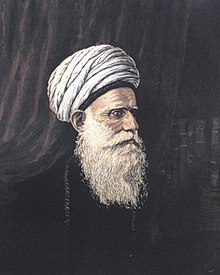| Sheikh ul-IslamAhmad Huseynzadeh | |
|---|---|
 Portrait by Ali bey Huseynzade, 1900 Portrait by Ali bey Huseynzade, 1900 | |
| Title | Third Sheikh ul-Islam of the Caucasus |
| Personal life | |
| Born | 1812 Salyan, Shirvan Khanate |
| Died | December 17, 1887(1887-12-17) (aged 74–75) Tbilisi, Russian Empire |
| Religious life | |
| Religion | Islam |
| School | Shia |
| Muslim leader | |
| Based in | Tbilisi, Russian Empire |
| Post | Sheikh ul-Islam of the Caucasus |
| Period in office | 15 October 1852-1884 |
| Predecessor | Fazil Iravani |
| Successor | Mirza Hasan Tahirzadeh |
Ahmad Huseinzadeh (Azerbaijani: Əhməd Hüseynzadə) also known as Sheikh Ahmad Salyani — third Sheikh ul-Islam of the Caucasus, maternal grandfather of Ali bey Huseynzade.
Early life
He was born in Salyan in 1812 to Ali Huseynzadeh. He was brought up initially from 1822 to 1832 in his hometown by his uncle Akhund Molla Muhammad Hussein. Then he became a student of the Baku mujtahid Akhund Molla Ramazan, and studied with him for another six years, until 1838 when he completed the full course of Arabic sciences.
Career
After graduation, he returned to Salyan in 1839 and started teaching various subjects to local children for 6 years. He later gained higher religious education in Najaf and Tbilisi. He was appointed as Sheikh ul-Islam by Alexander II of Russia after Fazil Iravani's resignation with a monthly pension of 1600 rubles on 15 October 1852. He was appointed as head of the Spiritual Council of Transcaucasian Shia Muslims, on 5 April 1875. His deputy was Akhund Mustafa Talibzadeh, father of Abdulla Shaig. He was described as a rather liberal-thinking cleric by Fatali Akhundzadeh and contributed to Akinchi, first Azerbaijani language newspaper. In his letter to Akhundzadeh in 1862, Yousuf Khan Mostashar al-Dowleh said of Huseinzadeh "I don't even consider him a mullah, but rather a spiritual cleric." Like Akhundzadeh, he was a promoter of the Latin alphabet for Azerbaijani and defended the idea that it is not incompatible with Sharia and Islam.
He resigned in 1884 and lived in Tbilisi where he died 3 years later.
Family
He was married to the daughter of his uncle Mahammad Ali Huseynzadeh, Husniyya Khanum and had two daughters with her:
- Fatima Huseinzadeh (b. April 1, 1844, d. 1890) — married to Hajji Muhammad agha, son of Hajji Mirza Hasan in Shamakhi
- Khadija Huseinzadeh — married to Molla Hussein Huseinzadeh, son of Kazim bey Huseinzadeh of Quruzma
- Ali bey Huseynzade
- Ismail Huseynzade (1868-1941) — married to his cousin Mina (b. 1878), daughter of Fatima Huseinzadeh, had issues
Works
- Muallim-ul atghal fi tarighe-talimi atfal (1875, Tbilisi)
- Basaul nas-fi-mamlakatul Kafkas (Nations of the country of Caucasus, uncompleted work)
- Tarikhi-adabiyyati-Turk (History of Turkic literature)
- Tarbiat-ul-atfal
- Dilgushah
Awards
- Order of St. Anna, 2nd class with Imperial crown (22 September 1871)
- Order of St. Vladimir, 3rd class (30 August 1881)
References
- "Photos: Two Quran manuscripts at Salyan Library of Azerbaijan". International Shia News Agency. 2020-06-05. Archived from the original on 2020-07-02. Retrieved 2021-06-14.
- "Forgotten paintings by Ali bey Huseynzadeh". Nargis magazine | Журнал Nargis. 2018-08-08. Archived from the original on 2020-07-18. Retrieved 2021-06-14.
- ^ Turan, Azar (2008). Ali bey Huseynzade (in Azerbaijani). Moscow: Salam Press. pp. 4–8. ISBN 978-5-7164-0582-0. OCLC 551019487.
- ^ "Формулярный список о службе председателя Шиитского духовного правления, Закавказского шейх-уль-ислама Ахунда Ахмеда Гусейн-заде · Russian Perspectives on Islam". islamperspectives.org. Retrieved 2021-06-14.
- Akhundov, Mirza Fatali (1962). Works (in Azerbaijani). Vol. 3. Baku: Azerbaijan National Academy of Sciences. pp. 265–266.
- Ahmad, Huseinzade (6 November 1881). "Ziya". No. 3.
| Religious Council of the Caucasus | |
|---|---|
| Sheikh al-islams | |
| Muftis | |